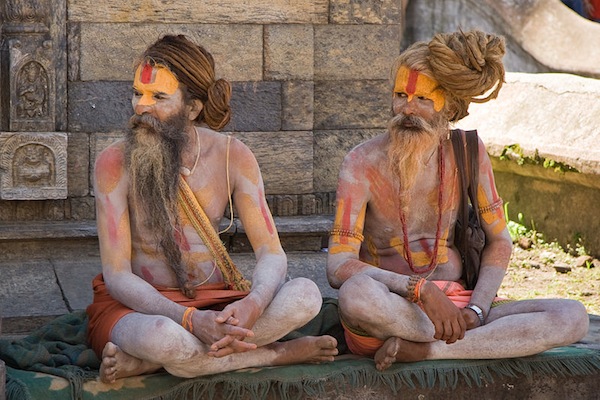Patanjali’s system of yoga is also known as Ashtanga Yoga, or yoga of 8 limbs or aspects. First 5 limbs are described as external or related to practices concerning with body and mental attitudes, and last three are concerned about exploring deeper layers of consciousness. Here short description of external steps is being given, then we will talk about Internal steps in details.
8 Steps (limbs) of Patanjali’s Ashtanga Yoga
1. Yama
Ahimsa (non violence), Satya (Truthfulness), Asteya (Non stealing), Aparigrah (not indulging in sensory pleasures), Brahmcharya (Knowing and acting according to nature)
2. Niyam
Shaucha (Purity), Santosha (contentment), Tapas (austerity), Swadhyaya (study of self), and Ishwar Pranidha (surrendering to the higher principle).
3. Asana
Now due to influence of Hatha Yoga it is taken as “practicing Body Postures to maintain optimum health”. But earlier it was mainly a comfortable seated position to practice next steps ie Pranayama etc. While practicing asana, concentration on a particular principle (e.g. infinite void) is recommended.
4. Pranayama
Breathing practices to purify pranic channel. asana and pranayama are well known for facilitating proper gross and subtle fluid flow (blood, lymphatic, chi, and pranic flow) in the body.
5. Pratyahara
Pratyahara is stopping the flow of information from outside by turning the mind inward.
All those 5 limbs mentioned above are Bahirang (external means) of yoga. They have more to do with body and cultivating conductive attitude of mind to make it more focused and ready for higher practices.
Now we describe (Antarang Yoga) Internal means of yoga.
6. Dhāraṇā
It is a Sanskrit (धारणा) word, translated as “collection or concentration of the mind, or “the act of holding, bearing, wearing, supporting, maintaining, retaining, keeping back (in remembrance), a good memory”, or “firmness, steadfastness, certainty”.[1] This term is related to the verbal root dhri to hold, carry, maintain, resolve. All these meanings indicate that dharana is holding the awareness of object of concentration.
“Dhāraṇā is the confining (or fixing) of the chitta in a single area [desha].” – Patanjali in Yoga Sutra. It is interesting that Patanjali does not say that Dhāraṇā is fixing the mind in a single spot (bindu), but rather says desha, area. This is because though the Chidakasha is indeed a single thing, it extends through the entire range of existence as the inner thread or sutra on which all is strung or fixed like beads in a necklace or rosary. When chitta is held in that place with unwavering attention, is called Dhāraṇā.
7. Dhyana
After practicing dharana for a significant time the mind develops the capability to remain fixed on a certain object internal or external. Flow of awareness becomes unbroken. This state is called Dhyana.
“Dhyana [eng “meditation” does not correspond exact meaning] is the unbroken flow of awareness [ekatanata] of that [desha or object].” In other words Dhyana is sustained concentration, whereby the attention continues to hold or repeat the same object or place. (Yoga Sutra 3.2)
Ekatanata can be understood as the unbroken movement or extension along something- It may be a mantra for instance or mental visualization of a symbol like Om “Dhyana is continuity of the experience of the object in concentration. As Vyasa says – It is a stream of identical vrittis [waves, modifications] which is untouched by any other vritti.” In Dhyana, mind is not distracted by opposing vrittis but it is firmly established in one unified stream.
8. Samadhi
With meditation, there is still an observer observing an observed. When the observer becomes extremely absorbed in the process of observing the object, the three collapse such that all there is only awareness of the object. This is when Dhyana (meditation)* becomes samadhi.
Samadhi is the state of consciousness in which oneness with the object of concentration or meditation is experienced. In meditation it is the experience of oneness with the individual spirit (purusha) or the Supreme Spirit (Param Purusha). Swami Sivananda, in the Yoga Vedanta Dictionary, says: “Here the mind becomes identified with the object of meditation; the meditator and the meditated, thinker and thought become one in perfect absorption of the mind.” From this we can see that samadhi is exclusively a state of awareness.
Dharana, Dhyana, Samadhi and English word Meditation
Dharana is maintaining a single focus in the mind’s eye. Dhyana has many components; it is usually translated as meditation, which does not carry the full import of dhyana. Here, an attempt is made to present the distinction between dhyana and meditation.
Meditation is a generic word stretching from sitting quietly to deep inward focus as practiced in many traditions. The official site of National Center for Complimentary and Alternative Medicine (NCCAM), USA, proclaims thus: “Meditation techniques include specific postures, focused attention, or an open attitude toward distractions. People use them to increase calmness and relaxation, improve psychological balance, cope with illness, or enhance overall health and well-being.” Thus, the definition of meditation is based on a mental process to calm and reduce psycho-physiologic load on a person due to reasons cited above. The consequence of such a practice is lowered metabolism that goes by the well-known phrase, relaxation response. Thus, in this official (and hence accepted) definition, there is no mention of the deeper levels of mental state reached in such states.
The same reflections can be found in the following reference …
In A Western Context “Meditation” in its modern sense refers to Yogic meditation that originated in India. In the late nineteenth century, Theosophists adopted the word “meditation” to refer to various spiritual practices drawn from Hinduism, Buddhism, Sikhism and other Indian religions. Thus the English word “meditation
Mystic Apprentice Volume 3: Meditative Skills with Symbols and Glyphs Supplemental:
Further the word meditation has also been used traditionally in a sense of thinking (intellectual process), discourse or reflection (thoughts), A good example would be a famous book “Meditations by Marcus Aurelius”
By Arvind Aditya
Lead Traininer at The Bodhi Center



